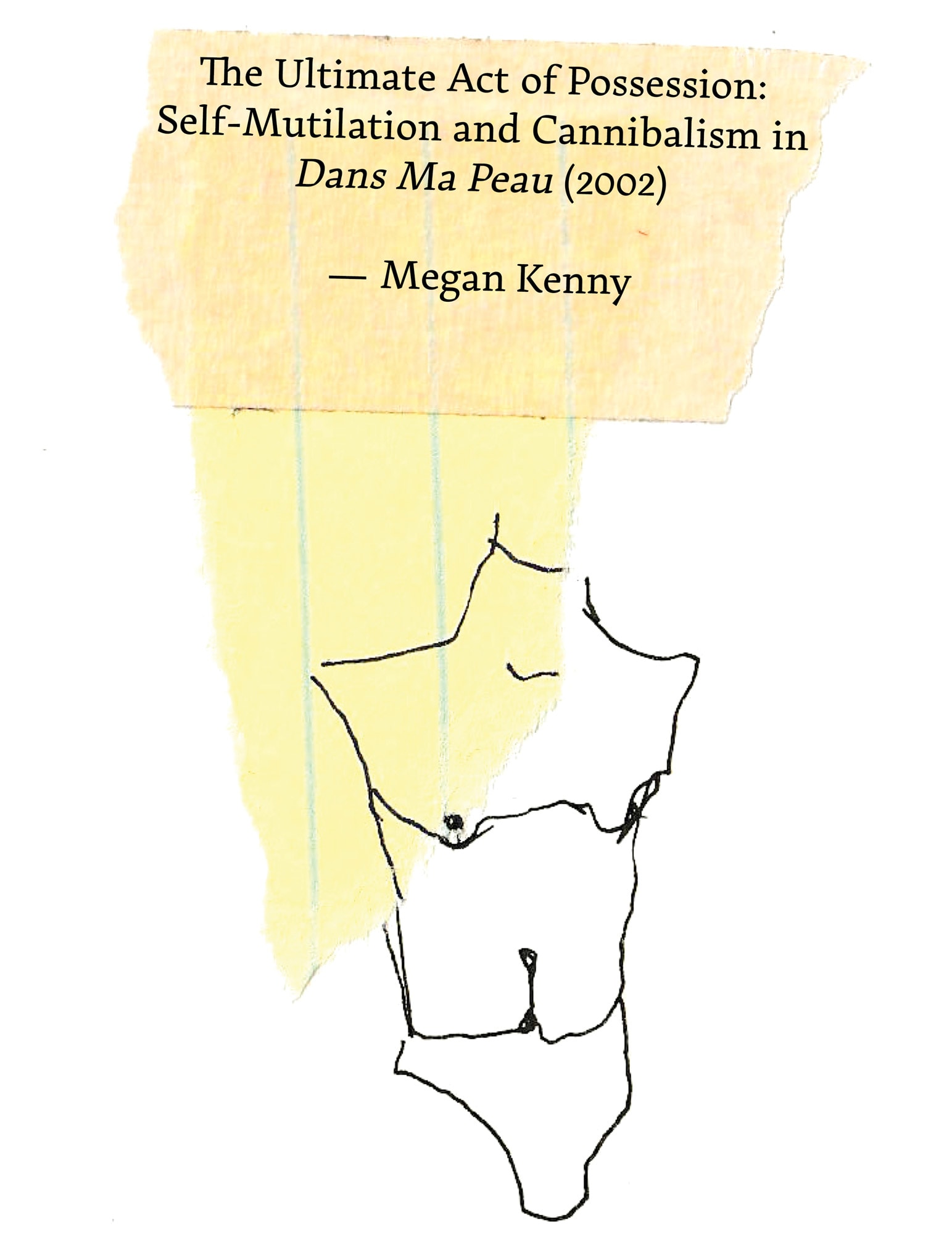The Ultimate Act of Possession: Self-Mutilation and Cannibalism in Dans Ma Peau (2002)

At its most literal, possession refers to ownership; either the act of owning or being owned. Within the horror genre, possession often refers to an external force or entity taking ownership over another, for example, via demonic possession in The Exorcist (1973), or serial killer trophy hunting in Silence of the Lambs (1991). In these cases possession is something to fear, it is something that is done to us by someone else, in an external act of ownership. But another facet of possession exists, one that is less often explored: the act of self-possession. Rather than being something to fear, self-possession can be a radical and powerful act. Women’s experiences are particularly interesting, specifically the ways in which women self-possess in a world that seeks to colonise and take ownership of them. An excellent example of this is Dans Ma Peau (2002) in which self-mutilation and self-cannibalism become the ultimate acts of self-possession.
Dans Ma Peau (In My Skin) is a French extremity film written and directed by, and starring, Marina de Van. It centres on Esther who appears to have it all: a good job, attentive partner and a vibrant social life. But as we start to scratch the surface, we see that beneath the veneer lies a growing sense of frustration. At a party she trips and injures her leg but fails to notice until a trail of blood alerts her to her wound some hours later. We see her fascination with the wound as she gets stitches and her growing enchantment with her own body as the film progresses, leading to more extreme acts of mutilation and consumption, finally culminating in a bloody night of self-discovery. There is a deep sense of voyeurism throughout the film, as though we are watching private reverential acts of self-love and Esther’s actions are almost masturbatory, as she digs her fingers into her own flesh. In the final act, as we watch Esther suck at her own thigh, drinking deeply from the well of herself, and see her fixation on a flap of her own skin, a sense of revulsion is complicated by a sense of respect for such devotion to her own body.
Clinically, Esther’s actions can be labelled as body-focused repetitive behaviour, or obsessive compulsive disorder, or more generally as self-harm. We see that she is not always in control of her behaviour, that her body at times appears to be acting autonomously, without her input. There is a compulsive aspect to her actions, and a release when she breaks the skin. But all of these labels are only descriptors and do nothing to relate the underlying causes of behaviour. As is so often the case, women are pathologised and medicalised, without any real attempt to understand the cause, only focusing on the symptom. If Dans Ma Peau is read only as a one-dimensional descent into mental illness, one that positions Esther’s actions as irrational and incomprehensible, we continue to perpetrate this pathologisation. We must look deeper into the cause of her behaviour, which appears to be rooted in her growing sense of frustration, of dissatisfaction with the life she is supposed to want.
Throughout the film, we see how Esther is prodded and poked by the people around her, from the doctor who treats her wound with an infantilising, patronising air, to her boyfriend who grows increasingly aggressive in his attempts to check her body for evidence of mutilation, to her boss who feels entitled to criticise her for not being the good flirtatious host at a client dinner. All of these interactions are rooted in misogyny, and in the patriarchal notion that women’s bodies need to be policed, that women are incapable of being the caretakers of their own lives. Esther’s reaction to this may be extreme, but it is rooted in an understandable desire for autonomy. This desire is first expressed through the usual channels, seeking a promotion at work, house hunting with her partner, trying to achieve the Western neo-liberal capitalist dream. But these attempts continue to feel hollow and it is only through the act of consuming herself that Esther finds freedom.
Esther’s actions are unsettling; they look painful, despite her numbness, they are socially awkward, like her inability to stop slicing herself with a steak knife at a work dinner, they make her insular and self-obsessed. And it is in this insularity that the real issue arises, her partner, friends and colleagues can’t reach her, because they can’t understand her. She turns inward, on a journey of self-discovery that is unacceptable in a patriarchal society. For her to be self-obsessed, to become fixated on her own body without concern for the gaze of others, to be engaging in acts that actively disrupt that gaze, is to contradict the status quo. Indeed, Esther’s self-possession is the ultimate transgressive act because it is purely driven by her internal eye, with no concern for the external gaze. In fact, through her continued cutting, maiming and scarring, she is making herself, by Western beauty standards, uglier and thus less palatable for the male gaze. Through Esther’s actions we see the hypocrisy of this approach. When women are slicing and dicing themselves in the name of conforming to acceptable beauty standards under the guise of ‘self-improvement’, that is acceptable, even ‘empowering’; when women are rotting their teeth through purging so they can be thin enough, weak enough, small enough then these are acceptable levels of self-harm. But when a woman chooses to desecrate her own flesh for the purposes of her own enjoyment and fulfilment, she becomes morally, socially and culturally repugnant.
We must also consider the significance of the act of breaking the skin. We can see it as a metaphor for Esther breaking through the taut skin of a life that does nothing but constrict, of a relationship that doesn’t inspire, a job that doesn’t interest, of a life of mediocrity that has been positioned as the ultimate goal for the modern woman. This mediocrity stretches like a caul over Esther suffocating and smothering her, yet in the act of breaking through the skin, something breaks out. It’s interesting to note that she doesn’t feel her injuries, that she’s numb, again, this acts as a metaphor for the numbness that she feels in her own life. It is only by continuing to pick and poke and stab and tear that she can dig in to dig out the essence of who she is and in that way ultimately possess herself for herself and no one else.
With the erosion of women’s bodily autonomy going from creepily insidious to aggressively explicit in recent years, films about our desire to remain autonomous and in charge of our own bodies and lives have never been more important. Representations like Esther’s may be frightening, challenging, and even difficult to watch, but as we witness Esther break through her skin, and fall in love with her own flesh, we can be inspired by the empowerment that such self-love brings.
Dr Megan Kenny is a writer, folklorist, parapsychologist and researcher based in Manchester. Research interests include folklore (and folk horror), the social and cultural significance of paranormal belief, explorations of horror cinema, the impact of trauma and positive representations of sex and sexuality. Alongside her research, Megan is part of the Monstrous Flesh collective and is the co-host of the Monstrous Flesh podcast. She writes about her love of horror cinema for a number of outlets including Ghouls Magazine and Hear Us Scream.
Twitter: monstrous_meg
Instagram: monstrous_meg
